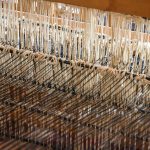You’ll love acetate fabric for its silky sheen, smooth feel, and elegant drape that mimics silk at a lower cost. It resists wrinkles and holds vibrant colors well, making your clothes look luxurious. But be careful—acetate is sensitive to heat, wrinkles easily, and can stain from water spots. It needs gentle care like hand washing and low-heat ironing. If you want to know how acetate compares to other fabrics and the best ways to care for it, keep exploring.
Table of Contents
Key Takeaways
- Acetate fabric offers a silky texture and elegant sheen, mimicking silk at a more affordable price.
- It drapes beautifully and retains vibrant colors due to excellent dye absorption.
- The fabric is lightweight, smooth, and moderately breathable, suitable for sensitive skin.
- Acetate wrinkles easily, is less durable, and sensitive to heat and moisture, requiring careful maintenance.
- Ideal uses include evening wear, linings, accessories, and home décor where style and smooth finish are prioritized.
What Is Acetate Fabric?
Acetate fabric is a type of synthetic material made from cellulose, usually derived from wood pulp or cotton fibers.
When you wear or use acetate, you benefit from its silky, smooth texture that mimics natural fibers like silk. You’ll notice it has a shiny appearance and drapes beautifully, making it popular for formal wear, linings, and home décor.
Acetate resists shrinking and wrinkles, so it tends to keep its shape well. However, it can be sensitive to heat, so you’ll want to avoid high temperatures when ironing or washing.
This fabric also absorbs dyes easily, giving you vibrant colors that last. Overall, acetate offers a blend of style and practicality, making it a versatile choice for various applications.
The Origins and Production Process of Acetate
You might be curious about where acetate fabric comes from and how it’s made.
It all started with historical developments in synthetic fibers, using raw materials like wood pulp and acetic acid.
Understanding the manufacturing techniques will help you see why acetate has its unique qualities.
Historical Development
Although it may seem like a modern invention, acetate fabric has roots dating back to the early 20th century when chemists began experimenting with cellulose derivatives.
You’ll find that acetate emerged as a synthetic textile alternative, designed to mimic silk’s luxurious feel but at a lower cost. The production process evolved quickly, involving the acetylation of cellulose to create a fiber that could be spun into yarn.
By the 1920s and 1930s, acetate became popular in fashion, especially for linings and elegant apparel. As you explore its history, you’ll notice that improvements in manufacturing techniques made acetate more accessible and versatile.
This fabric’s development reflects the broader industrial push toward synthetic materials that blend performance with affordability, shaping the textiles landscape you know today.
Raw Material Sources
The journey from early chemical experiments to popular fabric involved selecting the right raw materials and refining the production process.
When you explore acetate fabric, understanding its origins helps you appreciate its qualities.
Acetate primarily comes from cellulose, a natural polymer found in plants.
Here’s what you need to know about its raw material sources:
- Wood Pulp: The most common source, harvested from trees like cottonwood and pine. It provides the cellulose base.
- Cotton Linters: Short fibers left on cotton seeds after ginning, offering a purer cellulose form.
- Refinement Chemicals: Acetic acid and acetic anhydride react with cellulose to form cellulose acetate.
Knowing these ingredients clarifies how acetate blends natural and chemical elements before it becomes fabric you wear.
Manufacturing Techniques
Since acetate fabric starts with natural cellulose, its manufacturing process cleverly combines chemistry and craftsmanship to transform raw materials into versatile textiles. You’ll find that the process involves extracting cellulose, chemically treating it, and then spinning it into fibers. This method gives acetate its characteristic sheen and smooth texture.
| Step | Description | Purpose |
|---|---|---|
| Cellulose Extraction | Harvesting natural cellulose | Base material preparation |
| Acetylation | Reacting cellulose with acetic acid | Creating cellulose acetate |
| Dissolving | Dissolving acetate in solvent | Fiber formation |
| Spinning | Extruding fibers through spinneret | Fiber shaping |
| Finishing | Drying and setting fibers | Enhancing durability & feel |
Understanding these steps helps you appreciate acetate’s unique qualities.
Unique Characteristics of Acetate Fabric
Acetate fabric stands out for its silky texture and vibrant sheen, which can instantly elevate your wardrobe or home decor.
When you choose acetate, you’re getting a material with some unique characteristics that set it apart:
- Lustrous Appearance: Its natural sheen mimics silk, giving any item a luxurious look without the high cost.
- Soft Hand Feel: You’ll notice how smooth and lightweight acetate feels, making it comfortable to wear or touch.
- Moisture Sensitivity: Be aware that acetate reacts to moisture and heat, which can affect its texture and shape over time.
Understanding these traits helps you appreciate why acetate is favored for certain applications, even as you consider its care requirements.
Advantages of Using Acetate in Clothing
You’ll love how acetate feels against your skin with its silky texture that adds a touch of luxury to any outfit.
It also lets your skin breathe, keeping you comfortable throughout the day.
Let’s explore these benefits and see why acetate is a great choice for clothing.
Silky Texture Benefits
Although synthetic, acetate offers a silky texture that feels luxurious against your skin.
When you choose acetate clothing, you get to enjoy a smooth, lustrous finish that mimics natural silk without the high price tag. This fabric drapes beautifully, making your outfits look effortlessly elegant.
Here are three key benefits you’ll appreciate:
- Softness – Acetate’s smooth feel reduces irritation, making it great for sensitive skin.
- Shine – Its natural sheen enhances colors, giving your clothes a vibrant, polished look.
- Drape – The fabric flows nicely, flattering your body shape and adding sophistication to any garment.
Breathability and Comfort
Comfort plays an essential role when picking fabrics for your wardrobe, and acetate delivers in this area more than you might expect.
While acetate isn’t as breathable as natural fibers like cotton or linen, it still offers moderate breathability that keeps you feeling comfortable in various settings. Its smooth surface allows moisture to evaporate reasonably well, helping reduce that sticky, clammy feeling during warmer days.
Plus, acetate drapes beautifully, which means it won’t cling uncomfortably to your skin. If you’re looking for a fabric that balances softness with decent airflow, acetate is a solid choice.
Just remember to layer thoughtfully in hot, humid conditions, as acetate alone won’t provide the same ventilation as some other fabrics. Overall, it’s a comfortable option that looks and feels luxurious.
Benefits of Acetate for Home Textiles
Acetate offers several advantages that make it an excellent choice for home textiles. When you choose acetate, you benefit from its luxurious appearance, which mimics silk’s smooth and shiny finish, instantly elevating your décor.
Plus, it’s resistant to wrinkles, so your curtains and pillow covers stay crisp without much effort.
Here are three key benefits you’ll appreciate:
- Vibrant Colors: Acetate holds dyes well, ensuring your textiles maintain rich, vivid colors over time.
- Soft Texture: It feels smooth against your skin, making it ideal for items like bed linens and cushions.
- Lightweight: This fabric drapes beautifully without adding bulk, perfect for elegant window treatments.
These qualities make acetate a smart, stylish pick for enhancing your home environment.
Common Drawbacks of Acetate Fabric
Anyone considering acetate should also be aware of its limitations.
For starters, acetate tends to wrinkle easily, which means your garments might require frequent pressing to look their best. It’s also less durable than other fabrics, so it can wear out faster, especially with heavy use.
You’ll find that acetate is prone to water spots and can shrink if exposed to moisture, so spills could cause permanent marks.
Additionally, acetate has a low heat tolerance—high temperatures from irons or dryers can damage the fabric. It’s also not very resistant to abrasion, meaning it can snag or pill over time.
Keeping these drawbacks in mind helps you decide if acetate suits your needs despite its appealing sheen and softness.
Care and Maintenance Tips for Acetate Garments
While acetate offers a beautiful sheen and softness, you’ll need to handle it with care to keep your garments looking their best. This fabric is sensitive to heat, moisture, and harsh chemicals, so proper maintenance is key.
To care for your acetate clothing, follow these tips:
- Wash Gently: Always hand wash in cold water with mild detergent or use a delicate cycle. Avoid wringing to prevent damage.
- Dry Carefully: Lay flat or hang to air dry away from direct sunlight and heat sources. Never use a dryer, as heat can distort the fabric.
- Iron with Caution: If ironing is necessary, use the lowest heat setting and place a pressing cloth between the iron and fabric to avoid melting or shine marks.
Comparing Acetate With Other Fabrics
Taking care of acetate requires special attention, but how does this fabric stack up against others you might choose?
Compared to cotton, acetate feels silkier and drapes more elegantly, though it’s less breathable and more prone to wrinkles.
Unlike polyester, acetate offers a more luxurious sheen but doesn’t hold up as well under heat or heavy wear.
When you compare acetate to silk, both have a smooth finish, but acetate is generally more affordable and easier to clean, though less durable.
If you’re deciding between acetate and rayon, acetate resists stretching better but can be more sensitive to moisture.
In short, acetate balances visual appeal and affordability but demands careful handling compared to more resilient or natural fabrics.
Ideal Uses and Applications for Acetate
Because acetate offers a silky feel and a lustrous finish, you’ll find it ideal for elegant clothing like evening gowns, linings, and blouses.
Acetate’s silky feel and lustrous finish make it perfect for elegant gowns, linings, and blouses.
Its smooth texture enhances comfort and style, making it a favorite in fashion. Beyond apparel, acetate shines in other practical applications. Here’s where you can use it effectively:
- Home décor: Acetate’s sheen adds sophistication to curtains and upholstery.
- Accessories: Scarves, ribbons, and hats gain a polished look with acetate’s smoothness.
- Costumes: Its lightweight and drape make it perfect for theatrical and dance costumes.
When you choose acetate, you’re opting for fabric that balances beauty with versatility, making it a smart choice for both fashion and function.
Frequently Asked Questions
Is Acetate Fabric Environmentally Friendly or Biodegradable?
You shouldn’t expect acetate fabric to be fully environmentally friendly or biodegradable. It’s derived from wood pulp but undergoes heavy chemical processing, which limits its biodegradability and raises concerns about its ecological impact.
Can Acetate Fabric Cause Allergies or Skin Irritations?
Ever wondered if acetate fabric could irritate your skin? While rare, some people might experience allergies or irritation due to chemicals in the fabric or dyes. If you have sensitive skin, it’s best to test it first.
How Does Acetate Fabric Perform in Extreme Weather Conditions?
You’ll find acetate fabric isn’t great in extreme weather; it struggles with moisture in humidity and can lose shape in heat. It’s better suited for moderate conditions, so avoid wearing it in harsh climates to stay comfortable.
Is Acetate Fabric Safe for People With Sensitive Skin?
You might think acetate feels smooth, yet it can irritate sensitive skin due to its synthetic nature. If you have allergies, you’ll want to test it first, but many find it comfortable and hypoallergenic.
What Are the Best Types of Dyes for Acetate Fabric?
You’ll want to use disperse dyes for acetate fabric since they bond well with its synthetic fibers, offering vibrant, long-lasting colors. Acid dyes can also work but might not be as durable or vivid on acetate.
- The Use of Nonwovens in Construction and Civil Engineering - July 11, 2025
- The Use of Nonwovens in Construction and Civil Engineering - July 11, 2025
- The Use of Nonwovens in Construction and Civil Engineering - July 11, 2025







